Creating the Activity
Activities define what happens when the connection is made to the external data source. Activities can be created to retrieve information from a data source and populate a field in a Domino database or to take the data in a Domino database field and update the back-end data source. In other words, an activity defines the relationship between the Domino application and the data source.
So, you're now ready to create an activity. When Create Activity is chosen from the Navigator pane, the activity form appears, as shown in Figure 22.5. The dialog box that pops up appears every time you create a new activity unless you turn off the User Assistant from the Navigator pane.
Figure 22.5. The Creating a Virtual Fields Activity dialog box appears as long as the User Assistant is turned on.

NOTE
To turn the User Assistant off, click the Disable Assistant hotspot label. If you want to turn the User Assistant back on, simply click the Enable Assistant hotspot label again.
After you close the dialog box, another one pops up with a list of Notes databases from which to choose. Select the appsCust6.nsf database as shown in Figure 22.6.
Figure 22.6. The Select Domino Database dialog box provides a list of available databases to choose from.

After you select the Customer database, you get another dialog box that prompts you for the form, or metadata, that you want to use from the Customer database. Select the CustKey form, as shown in Figure 22.7.
Figure 22.7. The Notes Selection dialog box is where you select the form to use in mapping the data.
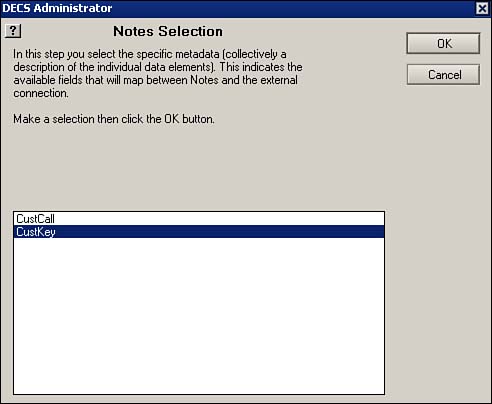
When you select the form, you get another dialog box that prompts you for the ODBC connection that you'll use to connect to the external data source. Select the CUSTOMERR6 data source (or whatever you have named your ODBC connection), as shown in Figure 22.8.
Figure 22.8. The Select Connection dialog box lists all the connections that have been created in the DECS Administration database.
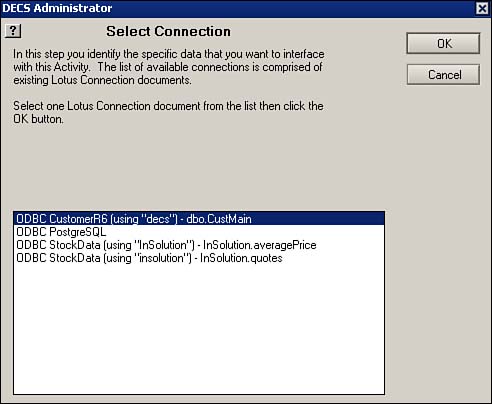
The Custdata table is selected as it was defined in the Connection document, so now you're ready to begin mapping fields. From the Key and Data Field Mapping section of the form, select the appropriate fields as indicated in Figure 22.9.
Figure 22.9. The Key and Data Field Mapping section shows the fields in each of the data sources and enables you to define how they're mapped.
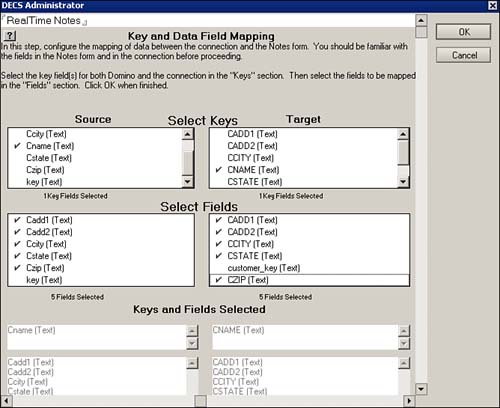
To map the fields, you simply check the field names that you want to use as the key fields and the fields that you want to be able to access.
Next , you need to make a few key decisions for this activity. The first decision is which events you want to invoke for the application. The available events are listed in Table 22.2. You're going to invoke all the events because you want to be able to both access the external data in the documents and add new and modified data back to the external data source as data is added and changed in Notes.
Table 22.2. Events
| Event Name | Description |
|---|---|
| Create | Creates a new record in the external data source when a new document is created in Notes |
| Open | Populates the Notes document with the data from the external data source |
| Update | Modifies the data for the record in the external data source when the Notes document changes |
| Delete | Deletes the record in the external data source when the Notes document is deleted |
Next, you have to set up any options that you need to use. By expanding the Options section, as shown in Figure 22.10, you can set the general options and then determine which options to choose for each of the events that you've invoked. You will not change any of the defaults for the available options.
Figure 22.10. The expanded Options section of the Activity document provides a place to define additional processing that should take place when an event is invoked.
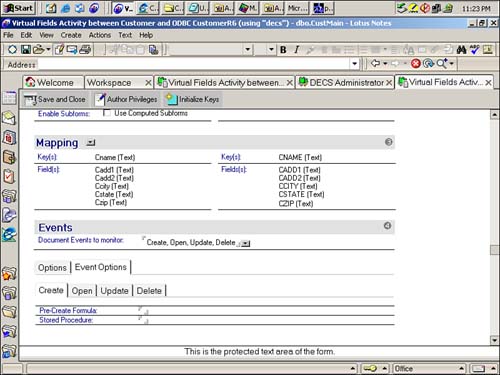
General Options
The general options apply to all the events that have been enabled for the activity. These options are shown in Figure 22.11.
Figure 22.11. The general options for an activity are applied to all events.
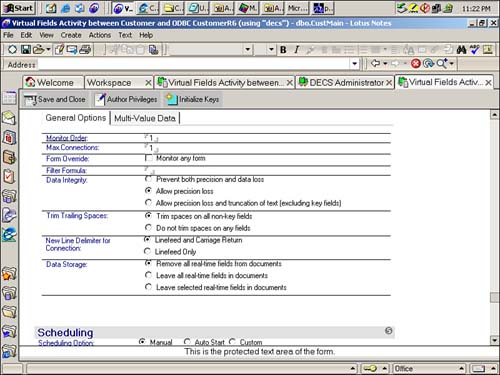
The first option is Monitor Order. This is useful if there are multiple activities running against the same form that have to occur in a specific order to be successful. That is, if you have an activity called B that needs data that is the result of another activity called A, you set Monitor Order to 1 for activity A and Monitor Order to 2 for activity B.
The second option is Max. Connections. This determines how many concurrent connections can be made to this data source at one time. A connection transaction occurs very quickly, so you should not have to set this to more than 2 or 3. Many ODBC connections accept only one connection at a time, and with a setting higher than 1, additional users connecting could encounter an error message if a connection is already established.
The third option is Form Override. You specified the form you'll use earlier in the Notes Application section of the activity document. By choosing to override the form, you're saying that for all events indicated here, you want to monitor all documents in the database that have the same key field data. For this application, you don't use this option, but instead have two separate activities: one for the customer data that monitors all events and one for the customer calls that monitor only the Open event.
The fourth option is Filter Formula, which provides the ability to set a formula to determine a subset of documents in the database to be monitored with this activity. This is useful if there are multiple external databases that should be accessed based on things such as region, business segment, and so on.
The Data Integrity options define what to do in the case of information entered into the application that doesn't conform to the requirements for the external data source, such as field lengths. Allow Precision Loss is the default.
The Trim Trailing Spaces options define how trailing spaces in the data in the external data source should be handled when it comes into Notes.
The Data Storage options determine whether the data that's retrieved from the external data source is actually saved with the document. By default, the data isn't saved. The other options are to store all the fields in documents or to select specific fields. So, when do you want to save the data? Save it if you have remote users accessing the application locally, if the application is on multiple servers and not all servers have DECS running, or if you want to create views that include any of the Virtual Fields. The Error Logging option determines where DECS errors are logged. The choices are to log to a document or to the Notes Log and the Activity log.
The Caching option should be used when there are a lot of changes written back to the external data source.
Document Creation Options
The document creation options are available only when creating a new document that is written back to the external data source. These options are displayed in Figure 22.12.
Figure 22.12. The document creation options in the activity document provide a means for running a stored procedure when the event occurs.
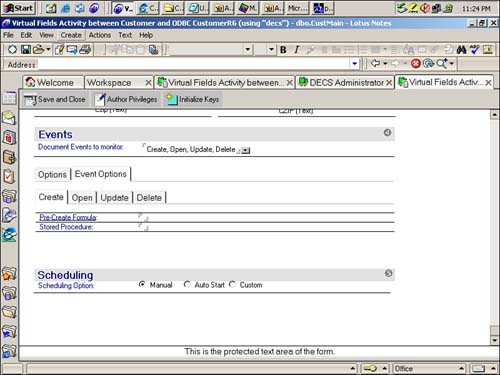
The Pre-Create Formula option provides an opportunity to have a formula run against the document before it's saved in the external data source.
The Stored Procedure option provides an opportunity to run a program that can manipulate the data for the external data source as the data is saved.
Document Open Options
The document open options are available only when opening an existing document, and are displayed in Figure 22.13.
Figure 22.13. The document open options of the activity document include additional options.
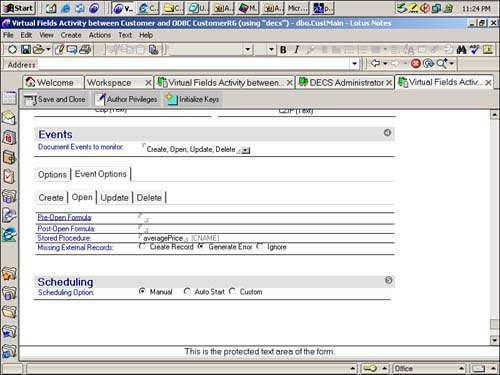
The Pre-Open Formula option provides an opportunity to execute a formula against the document before the external data is retrieved, thus allowing key updates to occur based upon information in the document.
The Post-Open Formula option provides an opportunity to manipulate the data being read into the document from the external data source. This is particularly helpful when you want to parse the data coming in from a specific field to place it in multiple fields in the document.
The Stored Procedure option provides an opportunity to execute a procedure that determines what data is retrieved based on the query.
The Missing External Records option provides an opportunity to have a new record written in the external data source if the key isn't found when opening an existing document.
Document Update Options
The document update options are available only when editing an existing document that's written back to the external data source. The document update options are displayed in Figure 22.14.
Figure 22.14. Document updates can be further defined in the Options section of the activity document.

The Pre-Update Formula option runs a formula as specified against the data prior to updating it in the external data source.
The Stored Procedure option provides an opportunity to run a procedure that can manipulate the data for the external data source as the data is saved.
The Conflict Detection option checks to see whether the matching record in the external data source has changed since it was opened. If it has, the update fails.
The Field Level Updates option updates fields in the external data source only if the fields have been edited in the Notes document.
The Key Field Updates option determines how changes to key fields made in the Notes document are handled in the external data source. The first option is to block all key field changes, which means that a key field cannot be changed in Notes or the external data source. The second option is to delete the existing record in the external data source and then insert a new record with the new values. The last option is to ignore the changes in Notes and do nothing to the record in the external data source.
Document Deletion Options
The document deletion options are available only when deleting an existing document in the external data source; they're displayed in Figure 22.15.
Figure 22.15. The document deletion options for the activity document only provide additional options for running a stored procedure or formula.
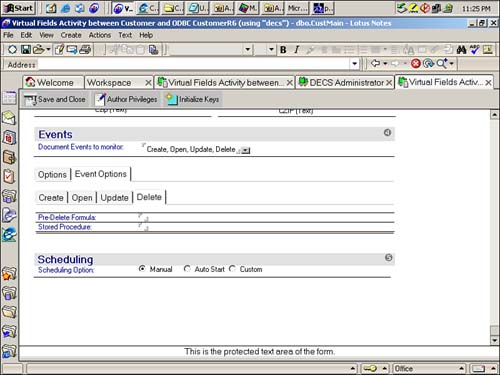
The Pre-Delete Formula option provides an opportunity to specify a formula that is to run prior to deleting the document.
The Stored Procedure option runs a named procedure on the external data source when deleting the record.
Creating an Activity Without the User Assistant
In your application, you can retrieve the customer data in the customer documents and you can also create documents to log calls from customers. To create customer calls that also display the customer information that's stored in the external data source, you must have another activity to support the open activity for the custcall form.
So, create this activity without the aid of the User Assistant. First, turn off the User Assistant by clicking on the "Disable Assistant" hotspot label in the Navigator pane, as shown in Figure 22.16.
Figure 22.16. The User Assistant is turned off when the hotspot in the Navigator says Disable Assistant.
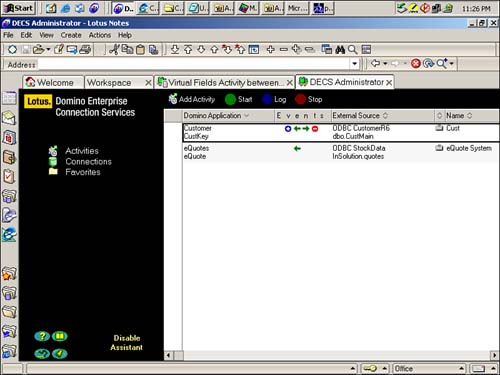
Next, create a new activity and name it CallTrack. Then click the button next to the Notes Application label. This brings up the dialog box to select the database to monitor. Choose the appsCust6.NSF file and click OK. This then invokes the dialog box to select the form to monitor. Choose the Customer Call form and click OK. Your selections should look like the selections in Figure 22.17.
Figure 22.17. The completed Customer Call Activity document shows both data sources selected.
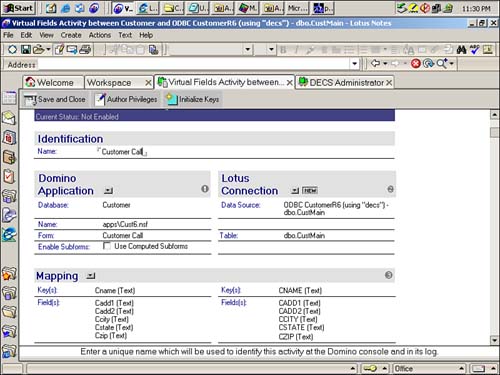
Next, choose the button next to the Lotus Connection. This brings up the dialog box to select the ODBC connection. Choose the CUSTOMERR6 connection (or whatever you've named the connection), and choose OK. This brings up the dialog box to select the table. Choose the CustMain table. Check Figure 22.17 to be sure that you choose the appropriate options.
Next click the button next to Mapping and map the fields as shown in Figure 22.17.
Lastly, choose just the Open event to monitor. That's it ”you're now ready to set up and test DECS in the application.
Part I. Introduction to Release 6
Whats New in Release 6?
- Whats New in Release 6?
- A Brief History of Lotus Notes
- Major Features of Lotus Notes
- Types of Applications
- Whats New in Domino Designer?
- New Design Element Features
- New Language Features
The Release 6 Object Store
- The Release 6 Object Store
- Defining a Domino Database
- Understanding the Database Structure
- Creating a Database
- Working with Database Properties
- Understanding Design Templates
- Creating Your Own Templates
- Inheriting Designs from Templates
- Using Templates to Replicate Design Changes
- Using Templates as Design Libraries
- Archiving Versions with Templates
The Integrated Development Environment
- The Integrated Development Environment
- Working in the Application Design Environment
- Working with the Properties Box
- Understanding the Work Pane
- Using the Programmers Pane
- Understanding the Info List
- Understanding the Action Pane
- Customizing the Tools Menu
- Printing Source Code
- Using the HTML Editor
- Locking Design Elements
Part II. Foundations of Application Design
Forms Design
- Forms Design
- Designing Forms
- Setting Form Properties
- Working with Text Properties
- Working with Fields
- Writing Formulas in Fields
Advanced Form Design
- Advanced Form Design
- Working with Tables
- Using Graphic Objects on Forms
- Working with Form-Level Events
- Using Form Actions
- Working with Hotspots
- Understanding Sections and Section Properties
- Using Layout Regions
- Working with Special Forms
- Creating Reusable Design Objects
- Using Embedded Elements
- Using the Form Design Document
Designing Views
- Designing Views
- Defining the Elements of a View
- Creating a View
- Setting View Properties
- Creating Advanced View Selections
- Adding and Editing View Columns
- Using View Column Properties
- Adding Actions to a View
- Creating Calendar Views
- Understanding Folders
Using Shared Resources in Domino Applications
- Shared Resources
- Sharing Images Within a Database
- Creating Shared Files
- Creating Shared Applets
- Shared Code
- Creating Subforms
- Creating Shared Fields
- Creating Shared Actions
- Script Libraries
- Database Resources
Using the Page Designer
- Using the Page Designer
- Understanding Pages
- Working with the Page Properties Box
- Using the Page Designer
- Adding Layers to Your Pages
Creating Outlines
- Creating Outlines
- Creating an Outline
- Working with Outline Entries
- Embedding Outlines
- Adding an Outline to a Frameset
Adding Framesets to Domino Applications
- Adding Framesets to Domino Applications
- Creating a Frameset
- Using the Frameset Designer
- Working with Frames
- Viewing the HTML Source of Your Frameset
- Launching the Frameset
Automating Your Application with Agents
- Automating Your Application with Agents
- Working with Agents
- Creating an Agent
- Working in the Agent Builder Design Window
- Using @Commands in Agents
- Putting Your Agent to Work
- Creating a Complex Agent
- Using LotusScript in Agents
- Creating Web Agents Using Formulas and LotusScript
- Using Java in Agents
- Testing and Debugging Agents, the Agent Log, and Agent Properties
- Agent Properties via the Agent InfoBox
Part III. Programming Domino Applications
Using the Formula Language
- Using the Formula Language
- Overview of the Formula Language
- Knowing Where to Use @Functions and @Commands
- Formula Syntax
- Limitations of the Formula Language
- Working with Statements
- Using Logical @Functions
- Working with Date and Time @Functions
- Working with Strings
- Getting Session and User Information
- Working with Documents
- Retrieving Data with @DbColumn and @DbLookup
- Working with Lists
- Getting User Input
- Controlling the Flow of a Formula
- Error Handling
Real-World Examples Using the Formula Language
- Real-World Examples Using the Formula Language
- Programming Practices
- Using Formulas in Forms and Subforms
- Writing Field Formulas
- Writing View Formulas
- Using Hide When Formulas
- Working with Forms, Views, and Shared Actions
Writing LotusScript for Domino Applications
- Writing LotusScript for Domino Applications
- Software Construction
- Fundamental Elements of LotusScript
- New Technologies and LotusScript
Real-World LotusScript Examples
- Real-World LotusScript Examples
- Real-World Example 1: Importing a Delimited Text File
- Real-World Example 2: Delete a Parent Document and All Its Children: DeleteParentAndChildren
- Real-World Example 3: Schedule an Agent Robot to Refresh All the Documents in a View: Robot-DailyRefreshAllDocs
- Real-World Example 4: Return a Web User to the Place Where He Started After a Document Is Submitted: WebQuerySave-DocSubmit
Writing JavaScript for Domino Applications
- Writing JavaScript for Domino Applications
- What Is JavaScript?
- JavaScript Is Not Java
- JavaScript and the Domino IDE
- The Document Object Model
- JavaScript Support in Domino 6
- When to Use JavaScript
- A Look at JavaScript in Domino
- JavaScript Libraries in Domino
- JavaScript Principles 101
- Syntax and Command Blocks
- Statements
- Output
- Functions
- Objects
- Input Validation
- Validating Check Boxes
- Validating Radio Buttons
- Validating Selection Lists
- Calculations
- JavaScript Application
Real-World JavaScript Examples
- Real-World JavaScript Examples
- Real-World Example 1: Dynamic Drop-Down Lists on the Web
- Real-World Example 2: Dialog Boxes and window. opener on the Web
- Real-World Example 3: Dynamic Tables
- Real-World Example 4: Useful JavaScript Utilities
Writing Java for Domino Applications
- Writing Java for Domino Applications
- Introduction to Java
- Choosing a Java Solution in Domino
- Understanding the Notes Object Interface
- Writing Java Agents
- Using Other Java IDEs
- Other Uses for Java
Real-World Java Examples
Enhancing Domino Applications for the Web
- Enhancing Domino Applications for the Web
- Whats New in Designer 6
- Understanding the Domino Web Application Server
- Understanding the Basics of HTML
- Using HTML in Domino Designer
- Adding Power with Domino URLs
- Views and Forms Working Together on the Web
- Incorporating Flash into Your Web Pages
- What Its All About: XML Exposed
- How Does Domino Use XML?
Part IV. Advanced Design Topics
Accessing Data with XML
Accessing Data with DECS and DCRs
- Accessing Data with DECS and DCRs
- What Is DECS?
- The External Data Source
- DECS Administrator
- Creating the Activity
- Accessing the Application
- DECS Summary
- Data Connection Resources
- DCR Example
- Tips on External Data Access
Security and Domino Applications
- Security and Domino Applications
- How Does Domino Security Work?
- Enabling Physical Security
- Setting Server Access
- Database Access Control Lists
- The Role of the Domino Directory in Application Security
- ACL Privileges
- Enabling Database Encryption
- Using Roles
- Implementing View-Level Security
- Implementing Form-Level Security
- Implementing Document-Level Security
- Applying Field-Level Security
- Hiding the Design of Your Application
Creating Workflow Applications
- Creating Workflow Applications
- The Evolution of Groupware
- Introducing Workflow
- Creating Mail-Enabled Applications
- Using Triggers to Send Email
- Sending Mail with LotusScript
Analyzing Domino Applications
Part V. Appendices
Appendix A. HTML Reference
Appendix B. Domino URL Reference
EAN: 2147483647
Pages: 288
- Assessing Business-IT Alignment Maturity
- Linking the IT Balanced Scorecard to the Business Objectives at a Major Canadian Financial Group
- A View on Knowledge Management: Utilizing a Balanced Scorecard Methodology for Analyzing Knowledge Metrics
- Managing IT Functions
- The Evolution of IT Governance at NB Power
